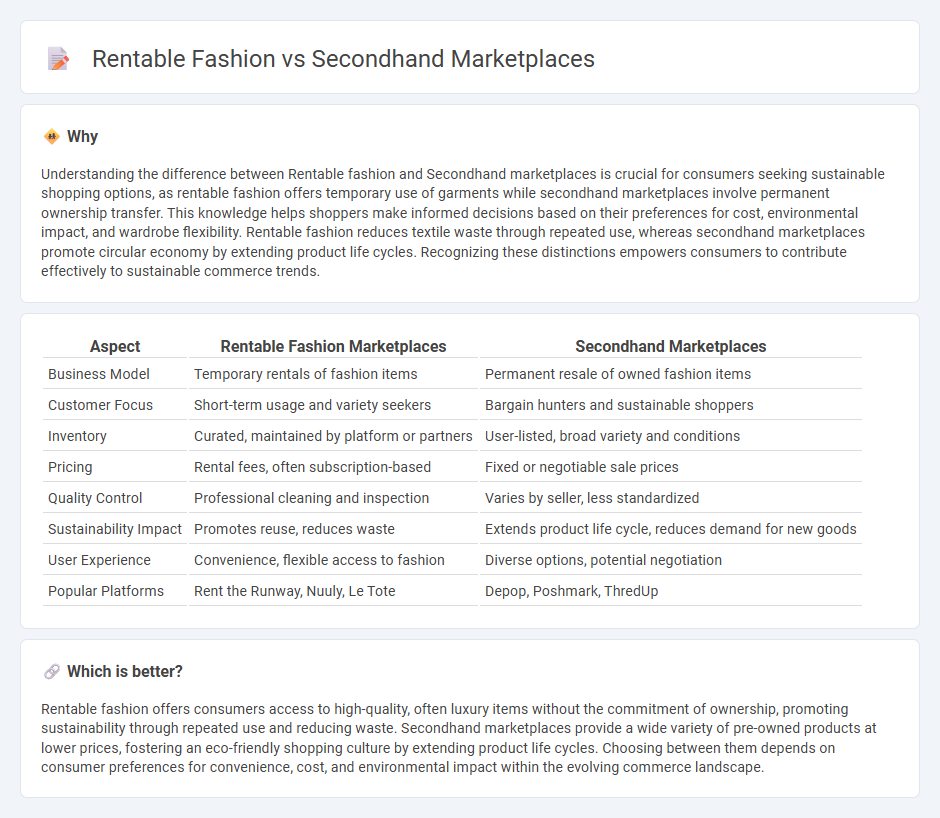
Rentable fashion platforms offer consumers access to a rotating wardrobe by leasing high-quality clothing for short-term use, reducing waste and promoting sustainable consumption. Secondhand marketplaces facilitate peer-to-peer buying and selling of pre-owned apparel, extending the lifecycle of garments and providing affordable options. Explore how these innovative commerce models are reshaping the fashion industry and contributing to circular economy practices.
Why it is important
Understanding the difference between Rentable fashion and Secondhand marketplaces is crucial for consumers seeking sustainable shopping options, as rentable fashion offers temporary use of garments while secondhand marketplaces involve permanent ownership transfer. This knowledge helps shoppers make informed decisions based on their preferences for cost, environmental impact, and wardrobe flexibility. Rentable fashion reduces textile waste through repeated use, whereas secondhand marketplaces promote circular economy by extending product life cycles. Recognizing these distinctions empowers consumers to contribute effectively to sustainable commerce trends.
Comparison Table
| Aspect | Rentable Fashion Marketplaces | Secondhand Marketplaces |
|---|---|---|
| Business Model | Temporary rentals of fashion items | Permanent resale of owned fashion items |
| Customer Focus | Short-term usage and variety seekers | Bargain hunters and sustainable shoppers |
| Inventory | Curated, maintained by platform or partners | User-listed, broad variety and conditions |
| Pricing | Rental fees, often subscription-based | Fixed or negotiable sale prices |
| Quality Control | Professional cleaning and inspection | Varies by seller, less standardized |
| Sustainability Impact | Promotes reuse, reduces waste | Extends product life cycle, reduces demand for new goods |
| User Experience | Convenience, flexible access to fashion | Diverse options, potential negotiation |
| Popular Platforms | Rent the Runway, Nuuly, Le Tote | Depop, Poshmark, ThredUp |
Which is better?
Rentable fashion offers consumers access to high-quality, often luxury items without the commitment of ownership, promoting sustainability through repeated use and reducing waste. Secondhand marketplaces provide a wide variety of pre-owned products at lower prices, fostering an eco-friendly shopping culture by extending product life cycles. Choosing between them depends on consumer preferences for convenience, cost, and environmental impact within the evolving commerce landscape.
Connection
Rentable fashion and secondhand marketplaces are connected through their shared focus on sustainable consumption and cost-effective access to clothing. Both models reduce demand for new production by extending the lifecycle of garments, promoting circular economy principles within the commerce sector. Consumer trends toward eco-conscious buying further drive the growth and integration of these platforms in the retail fashion industry.
Key Terms
Ownership Transfer
Secondhand marketplaces enable permanent ownership transfer by allowing users to buy and sell pre-owned fashion items, promoting sustainability through extended product life cycles. Rentable fashion platforms offer temporary access without ownership, catering to consumers seeking variety and reduced commitment while minimizing wardrobe waste. Explore the evolving dynamics between ownership transfer and sustainable fashion consumption for deeper insights.
Circular Economy
Secondhand marketplaces extend the lifecycle of garments by facilitating peer-to-peer sales and reducing textile waste, aligning with Circular Economy principles. Rentable fashion offers a sustainable alternative by promoting clothing reuse through temporary rentals, minimizing demand for new production and decreasing environmental impact. Explore the benefits and differences between these models for a more sustainable wardrobe.
Access-Based Consumption
Secondhand marketplaces offer consumers a sustainable option by enabling the resale and purchase of pre-owned fashion items, promoting circular economy principles and reducing textile waste. Rentable fashion focuses on access-based consumption, allowing users to borrow garments temporarily, which minimizes ownership and encourages frequent wardrobe refreshment without increasing environmental impact. Explore how access-based consumption is revolutionizing sustainable fashion and transforming consumer habits today.
Source and External Links
7 Online Marketplaces for Secondhand Items - Payability - eBay, Poshmark, ThreadUp, and Tradesy are leading online platforms where users can buy and sell secondhand goods ranging from clothes to accessories, each with their pros and cons regarding fees, user experience, and item variety.
The best online secondhand shops - one5c - Specialized secondhand marketplaces like AptDeco for home decor, OfferUp for local buying and selling, Toycycle for toys, and ThriftBooks for books provide curated experiences with quality checks and local options.
U.S. most used second-hand shopping websites 2022 - Statista - eBay remains the most popular online platform for secondhand shopping in the United States, with nearly two-thirds of surveyed consumers having purchased used items there in 2022.
 dowidth.com
dowidth.com